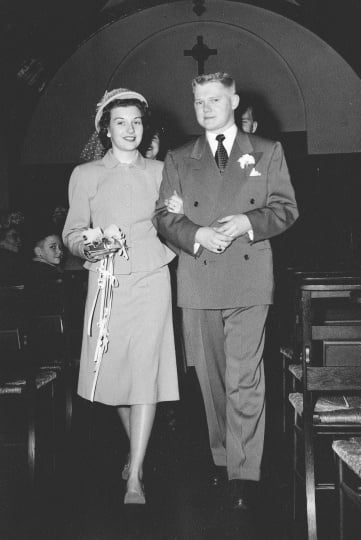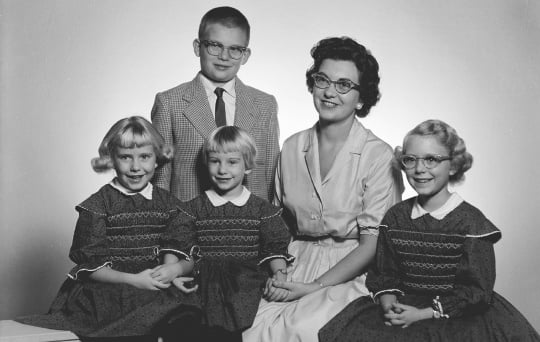Murder of Carol Thompson
Creator:
William Swanson
Carol and Cotton Thompson on their wedding day, March 27, 1948. Used with the permission of Margaret Chula.
.
Bibliography
Giese, Donald John. The Carol Thompson Murder Case. New York: Scope Reports, 1969.
O’Meara, Sheri, and Merle Minda. Famous Crimes: Stories of Law and Order in Minnesota. Minneapolis: D Media, 2008.
Swanson, William. Dial M: The Murder of Carol Thompson. St. Paul: Minnesota Historical Society Press, 2006.
Chronology
March 6, 1963
An intruder attacks housewife and mother Carol Swoboda Thompson in her St. Paul home. She dies of her injuries three hours later.
March 8, 1963
St. Paul homicide investigators interview T. Eugene Thompson at police headquarters. Thompson, who practices criminal law, says he knows of no reason anyone would harm his wife.
March 9, 1963
Following a private funeral closely watched by detectives, Carol Thompson’s remains are interred at Forest Lawn Cemetery in suburban Maplewood.
April 9, 1963
Four days after investigators publicly display fragments of a pistol grip recovered from the crime scene, a Luger handgun stolen from a Minneapolis apartment is identified as one of the likely murder weapons.
April 17, 1963
A Twin Cities man arrested in connection with a St. Paul robbery confesses to stealing the Luger and soon implicates several other local men as having discussed the Thompson murder prior to the killing.
April 19, 1963
Police in the Twin Cities and Phoenix, Arizona, arrest Norman Mastrian and Dick W. C. Anderson.
April 30, 1963
With the help of another man implicated in the case, police recover the Luger and remnants of Anderson’s bloodstained clothing from a swamp north of the Twin Cities.
June 20, 1963
Anderson confesses to attacking Carol Thompson and identifies her husband as having planned and paid for the murder.
June 21, 1963
T. Eugene Thompson is arrested at the Forest Lake cabin he shares with his in-laws and children.
June 25, 1963
A Ramsey County grand jury indicts Thompson, alleging that he intended to collect $1.1 million from life insurance policies he had purchased on his wife.
October 28, 1963
Following a court-ordered change of venue to Hennepin County, State of Minnesota v. Tilmer Eugene Thompson––described as Minnesota’s “trial of the century”––begins in Minneapolis.
November 26–December 3, 1963
Key prosecution witness Dick Anderson describes Carol Thompson’s murder in excruciating detail. Anderson is followed on the stand by the defendant, who insists he loved his wife and had nothing to do with her murder.
December 6, 1963
Exactly nine months after his wife’s death, Thompson is convicted of first-degree murder and sentenced to life in prison. The verdict is front-page news around the world.
February–June 1964
Mastrian is convicted of first-degree murder in a separate trial in Duluth, and Anderson pleads guilty to murder. Both men are given life sentences.
March 15, 1983
After several unsuccessful appeals and more than eighteen years in prison, T. Eugene Thompson, still proclaiming his innocence, is granted parole by the State of Minnesota.
August 7, 2015
Thompson, age eighty-eight, dies of natural causes in St. Paul.
Bibliography
Giese, Donald John. The Carol Thompson Murder Case. New York: Scope Reports, 1969.
O’Meara, Sheri, and Merle Minda. Famous Crimes: Stories of Law and Order in Minnesota. Minneapolis: D Media, 2008.
Swanson, William. Dial M: The Murder of Carol Thompson. St. Paul: Minnesota Historical Society Press, 2006.







